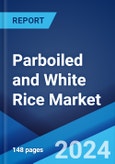The global parboiled and white rice market size was valued at 509.9 Million Tons in 2024. Looking forward, the market is forecast to reach 564.8 Million Tons by 2033, exhibiting a CAGR of 1.17% from 2025-2033. China currently dominates the market, holding a market share of over 35.2% in 2024. The parboiled and white rice market share is rising due to rising global demand for staple foods, increasing urbanization, and growing consumer preference for convenient and nutrient-rich rice varieties. Expanding trade, improved processing technologies, and higher consumption in Asia, Africa, and the Middle East further contribute to market growth.
Parboiled and white rice are variants of hydrothermally processed rice. Parboiled rice is partially boiled and is processed in lukewarm or cold water before husking and milling. White rice is usually milled after having the husk, bran and germ removed. They are a rich source of calcium, potassium, fiber and vitamin B6 and are widely used in dry powders, instant soup mixes and frozen foods. Parboiled and white rice are commonly available in long, medium and short lengths. They are widely used in ready-to-eat (RTE) breakfast cereals, biscuits, extruded snacks, baby foods, noodles, fermented beverages and oils. However, in comparison to white rice, parboiled rice is easy to digest, takes lesser time to cool and has a fluffier and less sticky texture.
This report provides an analysis of the key trends in each sub-segment of the global parboiled and white rice market report, along with forecasts at the global and regional level from 2025-2033. The report has categorized the market based on end use.
2. What is the future outlook of parboiled and white rice market?
3. What are the key factors driving the parboiled and white rice market?
4. Which region accounts for the largest parboiled and white rice market share?
Parboiled and white rice are variants of hydrothermally processed rice. Parboiled rice is partially boiled and is processed in lukewarm or cold water before husking and milling. White rice is usually milled after having the husk, bran and germ removed. They are a rich source of calcium, potassium, fiber and vitamin B6 and are widely used in dry powders, instant soup mixes and frozen foods. Parboiled and white rice are commonly available in long, medium and short lengths. They are widely used in ready-to-eat (RTE) breakfast cereals, biscuits, extruded snacks, baby foods, noodles, fermented beverages and oils. However, in comparison to white rice, parboiled rice is easy to digest, takes lesser time to cool and has a fluffier and less sticky texture.
Parboiled and White Rice Market Trends
Significant growth in the food and beverage industry across the globe is among the key factors creating a positive outlook for the market. Moreover, rising awareness regarding the health benefits of parboiled and white rice among the masses is providing a thrust to the market growth. The consumer preference is rapidly shifting towards an energy-rich carbohydrate-based diet and regular and moderate consumption of rice can minimize the risks of developing diabetes and various other medical ailments. In line with this, the increasing demand for premium and specialty white rice products and dishes is also favoring the market growth. For instance, basmati rice with sleek grains and unique aroma, taste and superior quality is gaining immense preference among the consumers. Additionally, extensive improvements in the rice production technologies and rising demand for rice flakes, puffed rice, rice wafers and canned rice, are acting as other growth-inducing factors. Furthermore, rising expenditure capacities of the consumers, along with the implementation of favorable government policies promoting the cultivation of rice, is anticipated to drive the market toward growth.Market Segmentation
This report provides an analysis of the key trends in each sub-segment of the global parboiled and white rice market report, along with forecasts at the global and regional level from 2025-2033. The report has categorized the market based on end use.Breakup by End Use
- Food Use
- Feed Use
Breakup by Region
- China
- India
- Indonesia
- Bangladesh
- Vietnam
- Others
Competitive Landscape
The competitive landscape of the industry has also been examined, along with the profiles of the key players.
This report provides a comprehensive analysis for setting up a parboiled and white rice manufacturing plant. The study covers all the requisite aspects of the parboiled and white rice industry and provides an in-depth analysis of the market, industry performance, processing and manufacturing requirements, project cost, project funding, project economics, expected returns on investment, profit margins, etc. This report is a must-read for entrepreneurs, investors, researchers, consultants, business strategists, and all those who are planning to foray into the parboiled and white rice industry in any manner.Key Questions Answered in This Report
1. How big is the parboiled and white rice market?2. What is the future outlook of parboiled and white rice market?
3. What are the key factors driving the parboiled and white rice market?
4. Which region accounts for the largest parboiled and white rice market share?
Table of Contents
1 Preface3 Executive Summary7 Competitive Structure10 Loans and Financial Assistance
2 Scope and Methodology
4 Introduction
5 Global Rice, Parboiled Rice and White Rice Industry
6 Myanmar Rice Industry
8 Parboiled and White Rice Manufacturing Process
9 Project Details, Requirements and Costs Involved
11 Project Economics
List of Figures
List of Tables
Methodology

LOADING...
Table Information
| Report Attribute | Details |
|---|---|
| No. of Pages | 133 |
| Published | February 2025 |
| Forecast Period | 2024 - 2033 |
| Estimated Market Value in 2024 | 509.9 Million Tons |
| Forecasted Market Value by 2033 | 564.8 Million Tons |
| Compound Annual Growth Rate | 1.1% |
| Regions Covered | Global |









